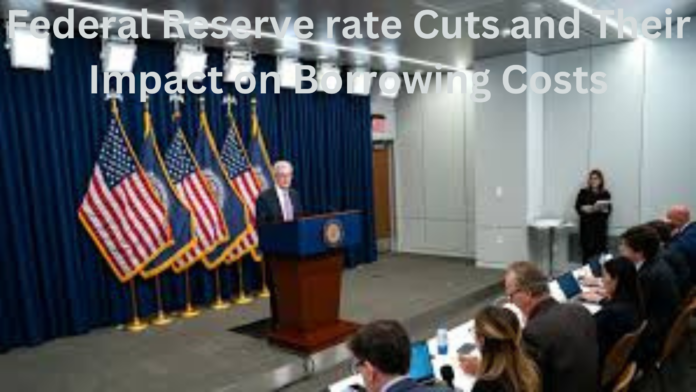The Federal Reserve’s decisions on interest rates make waves in the financial world. Whether you’re a homeowner refinancing your mortgage, a business owner expanding operations, or simply managing your credit card debt, a rate cut (or hike) can feel like a shift in the wind—sometimes a gentle breeze, other times a gale.
But what do these rate cuts mean for you, your wallet, and the broader economy? This blog dives deep into how Federal Reserve cuts impact borrowing costs, market growth, and your financial decisions. We’ll share relatable stories, actionable advice, and even a touch of humor to keep things light as we tackle this important topic.
What Are Federal Reserve Cuts?
At its core, the Federal Reserve (or “the Fed”) adjusts interest rates to keep the economy balanced. During times of economic slowdown or uncertainty, the Fed cuts rates to make borrowing cheaper, encourage spending, and stimulate growth.
How It Works
When the Fed lowers the federal funds rate:
- Banks Borrow Cheaper: This trickles down to consumers through lower interest rates on loans and credit cards.
- Money Moves Faster: Cheaper borrowing encourages spending and investment.
- Savings Earn Less: Lower interest rates often mean reduced returns on savings accounts and CDs.
Storytime: How Rate Cuts Helped a Small Business Thrive
Meet Jenna, a bakery owner in New York. Like many small business owners, Jenna struggled during an economic downturn. But when the Fed announced a rate cut, she saw an opportunity.
Jenna refinanced her business loan, reducing her monthly payments by $500. She used the savings to upgrade her equipment and hire an assistant baker. The result? Sales soared during the holiday season, and Jenna’s bakery not only survived but thrived.
Infographic Idea: The Domino Effect of Fed Rate Cuts
Title: “How Federal Reserve Rate Cuts Impact You”
| Area | Impact | Examples |
|---|---|---|
| Mortgages | Lower interest rates, reduced monthly payments | 30-year fixed mortgage drops from 6% to 4.8% |
| Credit Cards | Decrease in APR for variable-rate cards | APR drops from 18% to 16% |
| Auto Loans | Cheaper car financing | Monthly payments on a $25,000 loan decrease by $40 |
| Savings Accounts | Lower yields on savings and CDs | Savings account APY drops from 1.5% to 0.8% |
| Stock Market | Increased investor confidence, market growth | Stocks in tech and housing sectors rise |
The Impact on Borrowers
Rate cuts are a double-edged sword. They offer relief to borrowers but also demand vigilance. Here’s how they affect different borrowing scenarios:
1. Mortgages
If you’re a homeowner or prospective buyer, lower rates can significantly reduce your monthly mortgage payments.
Example:
- Before the rate cut: $300,000 mortgage at 6% = $1,799/month.
- After the rate cut: $300,000 mortgage at 5% = $1,610/month.
2. Credit Cards
Most credit cards have variable interest rates tied to the prime rate. A Fed rate cut can lower your APR slightly, but it’s still crucial to pay off balances quickly.
Pro Tip: Don’t rely on rate cuts to manage debt. Use them as an opportunity to get ahead on repayments.
3. Auto Loans
Cheaper car loans can make that dream ride more affordable. However, be cautious not to stretch your budget too thin.
4. Student Loans
If you have federal loans, rate cuts won’t impact your current repayment terms, but new borrowers may benefit from lower rates.
The Bigger Picture: How Rate Cuts Drive Market Growth
Beyond individual borrowers, rate cuts stimulate broader economic activity.
1. Business Expansion
Lower borrowing costs allow companies to invest in new projects, hire staff, and innovate.
2. Stock Market Rally
Investors flock to equities when rates are low, driving up stock prices. Sectors like tech, housing, and retail often benefit the most.
3. Real Estate Boom
Lower mortgage rates make homeownership more accessible, boosting demand in the housing market.
What About Savers and Investors?
While rate cuts are a boon for borrowers, they’re less exciting for savers.
1. Savings Accounts and CDs
Lower rates mean reduced returns on savings accounts and certificates of deposit.
Tip: Explore high-yield savings accounts or other investment options to maximize your returns.
2. Bond Market
When interest rates fall, bond prices rise, benefiting investors holding long-term bonds.
3. Stock Market Opportunities
Lower rates often lead to a bullish stock market. Consider diversifying into sectors poised for growth.
Reflection Questions
- How have rate cuts impacted your financial decisions recently?
- Do you prioritize paying off debt or saving when borrowing costs drop?
- What steps can you take to benefit from future rate cuts?
Actionable Advice for Navigating Rate Cuts
- Refinance Wisely
If you have a mortgage or personal loan, check if refinancing at a lower rate could save you money. - Pay Down High-Interest Debt
Use the breathing room from lower rates to tackle credit card balances and other high-interest debts. - Invest Strategically
Look for opportunities in growth sectors, but don’t overlook safe havens like bonds or high-dividend stocks. - Boost Your Financial Knowledge
Stay informed about how economic changes affect your financial landscape.Learn more about Federal Reserve policies at Investopedia.
Conclusion: Turning Rate Cuts Into Financial Wins
This Federal Reserve rate Cuts and Their Impact on Borrowing Costs, means Federal Reserve rate cuts are more than just economic maneuvers—they’re opportunities. For borrowers, they mean lower costs on loans, credit cards, and mortgages. For savers and investors, they require strategic adjustments to maximize returns and protect your financial future.
By understanding the ripple effects of these cuts, you can make informed decisions that benefit your wallet today and set you up for success tomorrow.
Have rate cuts impacted your finances? Share your story in the comments below, and let’s discuss how we can navigate the shifting economic landscape together. Don’t forget to share this guide—it could help someone turn rate cuts into real gains!


